|
|
Post by Lee Martin on Dec 19, 2016 19:49:52 GMT -5
Remington M6 pump .308 vs thrown water jug. Model Six----Ben “Bear Man” Kilham cut barrel to 16.8”, installed Ruger KAC556 flash hider and Pachmayr Decelerator pad. Schmidt & Bender 4x36mm in Ironsighter rings, which work with the 26mm tube; 180 grain soft point. While the German #4 reticle is excellent for speed, 4x magnification is excessive at close range. Shot is made through the narrow window between horizon line and ground. 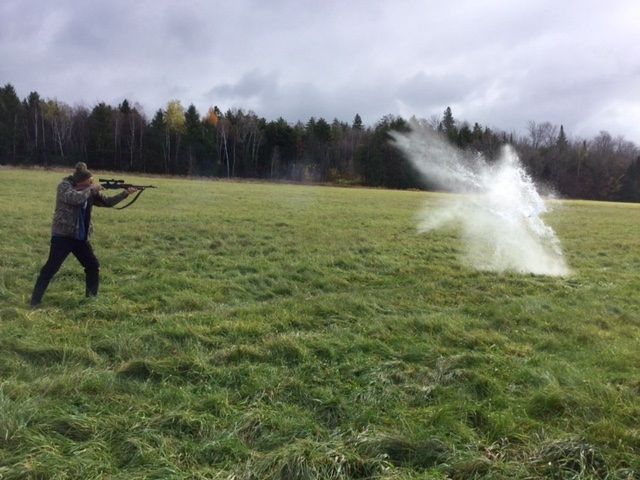 A pair of tangential nips on thrown jugs with Remington M700/Shilen .280 Ackley Improved with Leupold Vari-X III 3.5-10x50mm Adjustable Objective with German #4 reticle. Even at 3.5x, this is too much magnification, as all these shots begin with rifle at hip level. This is snap shooting with a twist----the serious intention to follow through. 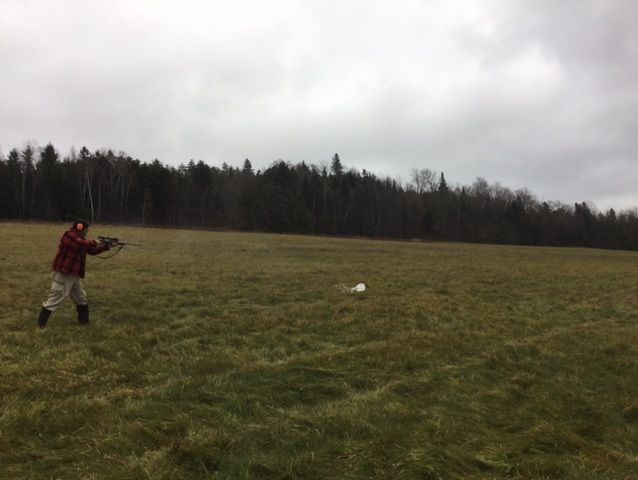 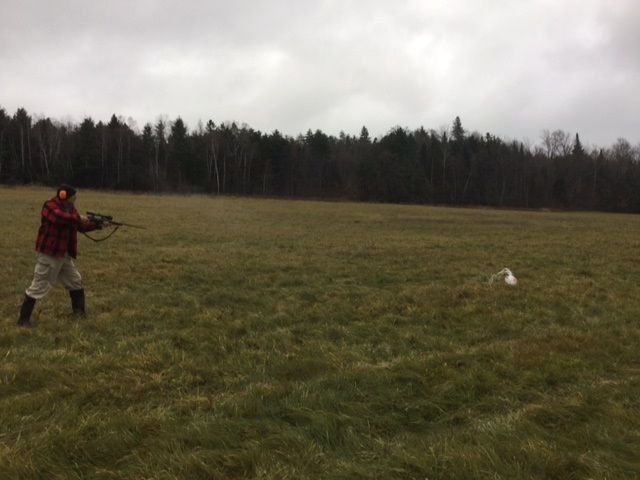 Rather than fight the over-magnified .280, drive it. Speed cannot fight grace and win, yet grace cannot get there alone----he two come together smooth as the jaws of a shark. Face erect, eyes square, not straining to get inside the scope----the scope comes to you----requiring the long eye relief which Leopold forced along with weatherproofing on the rest of the industry.  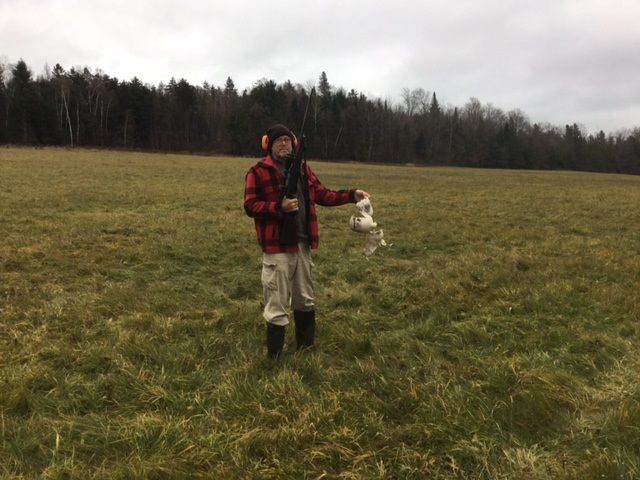 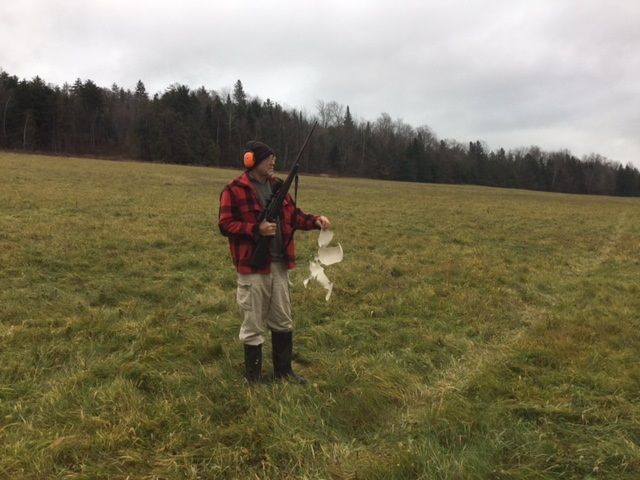 Thompson/Center Renegade .54 caplock, with Burris 2-3/4x Scout scope and German #1 (fence picket reticle.) Nothing special about the so-called speed of the Intermediate Eye Relief Scout scope. 440 grain T/C Maxi-Hunter over 78 grains/ffg black powder pulverizes thrown jug, mist instantly freezing in 15-degree fahrenheit. Immediately apparent, absolute need to follow through. Despite lock time of black faster than synthetic powder, ignition and barrel time are a lesson in what old time masters had to learn. 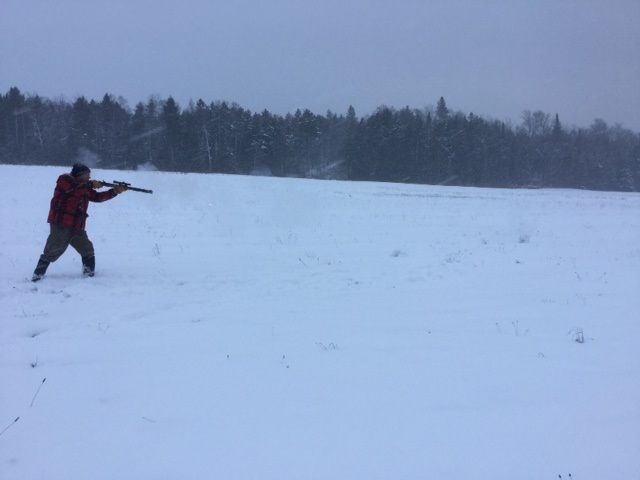 World War I Mauser 1898AZ 8x57mm. With only two rounds, pride drove the old eyes to grab a flash of the Mauser post & tangent sights. Although barely visible, 2x2 hits in the gathering dusk. Most satisfying for an original 1917 Erfurt Mauser. 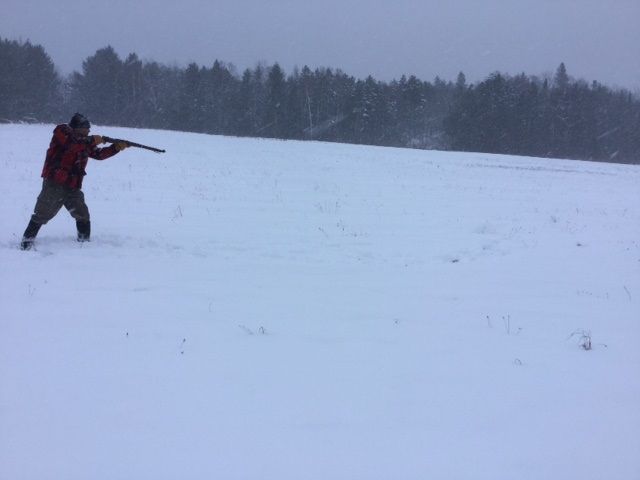  -Lee www.singleactions.com"Chasing perfection five shots at a time" |
|
|
|
Post by bradshaw on Dec 20, 2016 10:29:26 GMT -5
Again, thanks to Lee for posting. And thanks to seancass for working to make these essays accessible. Right off, we see AERIAL spelled wrong. I think “ariel" is a brand of lawn mower. Second, and more important, we need to put some die in the water jugs, as water vapor doesn’t show up against snow.
FIRE DISCIPLINE is the key to SAFE aerial shooting. Unless you have a mountain or cliff or sand wall for a backstop, the shooting of bullets must be withheld until the flying target crosses below the horizon line, or there is earth behind it. This visual conflict raises the challenge: first, on TRIGGER CONTROL and, second, FLASH SIGHT PICTURE. By DRY FIRE practice on crumpled paper, wood block, etc., we begin to glimpse the sights. S-Q-U-E-E-Z-E... Did I say SQUEEZE? Yes Mam Yes Sir.... S-Q-U-E-E-Z-E.
Fast as you squeeze the trigger, don’t jerk it. Writers wrung their pea brains for years to reinvent lingo for two terms which apply to pulling the trigger----squeeze and jerk. Whoever came up with “squeeze" and “jerk” got it right. We live in an age of euphemism, when people "pass away” instead of die; where, instead of drawing a pistol, you “make a presentation.” Instead of shooting a target, you “engage” it. For speed we squeeze faster----not jerk faster----as the pad of the index finger or its distal joint of the index finger sweeps back in line with the eye.
Motor skill
* Sqeeze----fine motor. Allows for follow through.
* Jerk----gross motor. No follow through.
Marksmanship begins with STANCE. Stance begins with BALANCE. Weight may shift forward as the gun comes up. A static, isosceles stance may slow “engagement” of moving targets. There are times when, to take a moving target, knees and elbows want to flex.
Throw the crumpled paper, knotted rag ,or wood block. Take your time----speed follows smooth. Your eyes watch the target, waiting for the sights to arrive. Sights find eye. By the time the sights find your eye the target is gone----practice puts the picture together. Take your time. Eventually, your eyes catch a flash of sight picture as it hunts for or intersects the target. Practice clarifies, sharpens the flash of sights. Practice FOLLOW THROUGH as an aspect of SQUEEZE.
David Bradshaw
|
|
|
|
Post by flyfisher66048 on Dec 23, 2016 21:55:11 GMT -5
Aerial targets used to be my favorite target with shotguns, rifles, and handguns growing up in NM. I used to be on the national team as an international skeet shooter, so I understand shooting at moving targets. There were plenty of Mountians to make it safe.
The first aerial target I shot was a soda water bottle my dad found while we were rabbit hunting. Dad said something along the lines of "so you think your good?" And he threw that bottle high in the air. I center punched it with my 243 shooting 85 gr Serria HPs. I guess there was a bit of pressure built up in that bottle because it blew up with a loud BANG. Dad smiled and said well I guess you are pretty darn good. That started me shooting aerial targets. My dad and I used to put on show where I would shoot hand thrown skeet targets with my 870. I could hit 5 hand thrown skeet targets from the hip with that shotgun.
The first gun I won shooting was a Remington speedmaster 22 lr. I used to shoot hand thrown charcoal briquettes. I could generally hit 3 or 4 hand thrown targets with it.
I picked up a colt ace 22 lr based on a 1911 pistol. Ammo was cheap back then, and I shot that pistol a bunch. I told my dad I was getting pretty good with it. We went shooting one day, and I was shooting pretty well with that pistol. Dad said let's see how good you really are, and picked up 10 38 special casings. He threw them up one by one. I managed to hit 7 of the 10 casings. Dad only gave me a C because I only hit 70%.
I don't get the chance to shoot airborne targets since I moved to KS, but it is lots of fun.
|
|
|
|
Post by bradshaw on Dec 23, 2016 23:11:24 GMT -5
flyfisher..... have a feeling, in his own mind your father gave you an “A.”
The shooting illustrated can be practiced on ranges with a good berm----providing the shooter has STONE COLD FIRE DISCIPLINE. Perhaps you will describe for SINGLEACTIONS a list of your coordinations----technique. What you see & do. Great shots have written about aerial shooting without articulating technique----the process for making hits.
David Bradshaw
|
|
|
|
Post by contender on Dec 24, 2016 8:41:02 GMT -5
Due to the lack of a safe place to practice this, I stopped being stupid (by shooting in the air w/o a proper backstop) long ago. But,,, when I got in the Army, I was a doorgunner on Hueys. Not the same,, yet similar enough to where I learned how to hit moving targets. Yes,,, I was using a M-60,,, but in my mind,, I wanted my hits to happen fast so I didn't heat up my barrel, and waste ammo. So I got to be a fair doorgunner. But as noted,,, it takes a lot to make it all happen, and I happen to admire those who have the skills to shoot like that. That said,,, these last 2 threads by David have given me ideas. (That can be dangerous sometimes,,,  ) I have a pretty high berm wall in one of my pistol bays on my range. I might have to re-visit my youth & see if I can do any of this. |
|
|
|
Post by flyfisher66048 on Dec 26, 2016 10:44:39 GMT -5
To be able to hit aerial targets I think you need four things: 1. A firm grasp on the basics of shooting, 2. A perfect gun mount, 3. The ability to shoot instinctively, 4. A way to practice.
1. The basics of shooting. If you can't hit the given target at the given range when the target is stationary, it will only be luck if you hit it in the air. The good news is the targets can be pretty good size, and the ranges are close. I bet everyone here can hit a charcoal briquette on demand at 20 feet with a rifle, so that should not be a problem. How much to lead a target? That depends on where it is its the flight path. There are three possibilities, on the way up, stationary, and on the way down. You have to shoot above the target on the way up. Aim directly at it when it is stationary at the top of the arch. Aim below it on the way down. The amount lead required at each stage of the arch is different because the speed of the target is different along the flight path. Additionally, the amount of lead required depends on the velocity of the round you are shooting. There is a difference between a 22 lr and a 243 win. If you are shooting at one aerial target, wait until it is at the apex of the arch and aim directly at the target. If you are shooting multiple targets shoot as many as you can near the apex, they will just be sitting there. Another key point is the eyes move before the gun. Lock your eye on the target you are fixing to shoot before start the gun moving. This will prevent moving the past the target and having to come back for it, or a miss. This one sure way to shoot faster if you have multiple targets. It also helps on shooting multiple stationary target such as a plate rack.
2. A perfect gun mount. For long guns the mounting of the gun must be perfect to shoot aerial targets. You don't have time to adjust your head to find the sights. The best way to perfect your gun mount, or draw for that matter is dry practice at home. With an unloaded gun, pick a handy spot on the wall, from a ready position mount the gun. Your sights should be exactly in the middle of the target with no adjustments, and you should have a perfect cheek weld on the stock. May as well take this time to practice squeezing the trigger. If it is a manual operating gun, work the action and fire again as fast as possible. Repeat for about 20 minutes per night. Work on getting the sights on target every time and getting a clean trigger break. It is helpful to practice this movement in slow motion. It helps create the mental pathways in your brain that allows you to perform these tasks at full speed. This practice will pay off in the hunting field. My dad taught me to Work manually operated rifles from the shoulder. A few years ago I was on a pig hunt in south Texas. This ranch requested we shoot the pigs in the head, so they would not have to track the pigs. No problem, as we were shooting pigs over corn. A pig wondered in while I was day dreaming about something else and laid down in a wallow. All I could see of him was about 1/ 2 of the top of his head. I thought, no problem that was all I needed. I took the shot and pulled it a little low in the dirt. I realized what I did, and worked,the Remington 700 bolt instinctively and lead the bolting pig and fired again hitting him through the lungs. It flashed in my mind that they wanted head shots, so I worked the bolt again and fired again. This shot hit,the pig between the eyes and ears dropping him instantly. I fired those rounds before the pig could run 30 yards.
3. The ability to shoot instinctively. Most hunters have a story of an animal that jumped up unexpectedly, and they were able to make the shot without even realizing they did it. Here is one of mine. After quail season in NM, Dad and I went rabbit hunting with our rifles. Mine was a Remington 700 in 243 with a red field 3x9 scope. Dad had his Win 43 in 22 hornet. We were hunting in sand dunes that had mesquite on the tops. The shots were all close and very fast, so we were tuned up for the fast targets. Unexpectedly a quail flushed in front of me. Without a thought, I killed that quail on the rise. My dad saw the whole thing, and he came over.. I thought he was going to be mad at me for shooting the quail out of season. Dads comment was he thought he trained me better than that! You should have shot that quail in the head rather than waste meat. Those shots are guided by the subconscious mind. The animal was identified, gun was mounted, sights aligned at the correct spot, gun fired and kept the gun moving all without conscious thought. It happens in a split second. The key is what most people call muscle memory. this is not the correct scientific term, but we all understand the concept. There are three tools that build on one another useful in developing that muscle memory Dry practice, visualization, and practice. Dry practice was discussed above, get the gun mount, sights on the target, and trigger pulled task perfect. Visualization is part of dry practice, or it can be used without even holding the gun. One of my favorite books on the subject is called "the inner game of golf". It turns out you can form the neural pathways of muscle memory by just visualizing the task.
4. A way to practice. you can practice with a BB gun. The best is an adult sized red Ryder BB gun. It is a slow enough velocity that you can see the bbs in flight, it posses little down range danger, and it is cheap. I put my son through a program called shoot where you look. It uses BB guns to train kids how to shoot shotguns at moving targets. The bb guns they use don't have sights on them. They don't want you to have to rely on sights to hit the target. I've seen a 10 year old kid shoot aspirins out of the air with one of those BB guns. Some real "Use the force Luke" stuff, but it works very well. Practice with the sightless BB gun until you can hit a quarter size,dot on a cardboard box by just mounting the gun and firing. No aiming. Next step is to swing the gun horizontal both directions until,you can hit the quarter. Then work on the other angles. Next move to shooting big moving targets, getting progressively smaller. It helps if you have a buddy to help throw the target. Wear safety glasses and start with a tennis ball, then ping pong ball, etc.
Rob
|
|
|
|
Post by jayhawker on Dec 27, 2016 0:41:51 GMT -5
Check out Lucky McDaniels. Made a living teaching aerial shooting with a BB gun. Sold the tecnique to the US military where his "Quick Skill" was known as "Quick Kill". He was a tobaco salesman. Would sell hesitant store owners by betting he could hit a pennie in the air with their .22 rifle. As things became more modern and not all general stores had a .22 in the corner, he started carrying a BB gun and hitting a BB in the air. Was the companies top salesman. One day a store owner said "I'll give you a $100 if you can teach me to do that", and he turned pro. My friend Joe Bowman, "the Straight Shooter" taught the same technique, using the long out of production full size copy of the Win. 94 BB gun.
|
|
|
|
Post by flyfisher66048 on Dec 30, 2016 8:53:57 GMT -5
Yea, following those guys teaching can sure save you a bunch of money in ammunition! There was a young lady that had never fired a gun, that went through the "shoot where you look" program, and won the TX sporting clay championship in the junior division.
|
|
|
|
Post by rangersedge on Jan 1, 2017 22:50:46 GMT -5
When I was young, i used to avidly read Bill Jordan and worked hard to get good at aerial shooting with a bb gun. Got pretty decent (not near you guys good though) with bb rifle and co2 powered bb pistol. Put a bb in the bottom of holster trying to go too fast without proper finger control. Bb probably still there if can find holster. Good thing was using bb pistol instead of that single six / colt I so badly wanted.
Edited to explain: I was tossing targets in air, then drawing / shooting with same hand.
|
|






















 ) I have a pretty high berm wall in one of my pistol bays on my range. I might have to re-visit my youth & see if I can do any of this.
) I have a pretty high berm wall in one of my pistol bays on my range. I might have to re-visit my youth & see if I can do any of this.